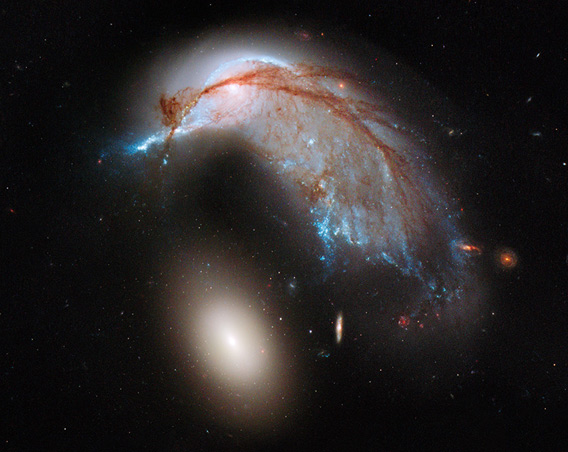The Hummingbird Galaxy
SLATE
Posted
Monday, July 15, 2013, at 8:00 AM

Most hummingbirds are significantly smaller than hundreds of quadrillions of kilometers across. Click to entrochilidaenate.
Photo by NASA/ESA/Hubble Heritage Team
Photo by NASA/ESA/Hubble Heritage Team
I was pondering writing a longish post about the picture above,
talking about what galaxies are, how they can physically collide, how
their gravity can twist and distort their shapes into all sorts of weird
things …
OK, you need a little more. For one, I’ve written quite a bit about how galaxy collisions happen, so you can read about how these work here and here.
The two galaxies in this collision are called NGC 2936 (the blue birdie
one) and NGC 2937 (the smaller cottonball one). Together they are known
as Arp 142, named for an astronomer who observed weird, distorted
galaxy pairs.They're located about 300 million light-years from Earth.
Two things really stand out to me in this picture (besides a galaxy
that looks like a flippin’ hummingbird). One is the long, delicate
tendril of dark reddish dust exhumed from the previously spiral-shaped
galaxy NGC 2936, flung into a long arc across tens of thousands of
light-years of space. I wish we had more three-dimensional data here;
I’d love to know what this structure really looks like from different
angles. Since dust is very dark, it blocks light coming from behind it,
so this tendril is in front of the hummingbird galaxy, or perhaps
embedded in it.
The other thing is that the smaller galaxy seems to have survived
this collision pretty well. The shape is only mildly distorted; you can
see a bit of off-centered nature to the glow of stars around the core. I
suspect its more compact nature has a lot to do with that; the stars
are closer together, perhaps, and the overall gravity of all those stars
helped it retain its shape.
And there is one other thing. These are two very different galaxies
colliding! The ex-spiral galaxy is very blue, indicating lots of star
formation happened recently. Young, massive stars are blue, and when
galaxies collide, the gravitational interaction can cause huge clouds of
gas to collapse and furiously form stars.
The other galaxy is yellower, indicating an older, more stable
population—blue stars don’t live long, so a galaxy this color must not
have formed stars in a long, long time. Billions of years, for sure. You
can tell by looking that it doesn’t have much gas and dust in it, which
fits; if it had, the collision would have stirred them up, and we’d see
more blue stars there as well.
Note too that you can see a handful of far more distant galaxies in
the picture. The ones to the lower right are red, which is most likely
due to having their light absorbed and reddened by the dust in the
hummingbird galaxy; that’s another thing interstellar dust does, much
like dust and haze in the air can make a sunset look red.
All in all, there’s a lot going on in this image! The hummingbird
shape makes me smile, and don’t get me wrong, it’s cool. But what you’re
seeing here is far more than just a shape in the clouds; you are seeing
a massive collision on a cosmic scale, the collective might of 100
billion suns, their gravity reaching out and twisting the shapes of
these galaxies, stretching them like taffy, molding them like clay.
The Universe operates on the grandest of all scales, manipulating
forces and energies far too large for us to grasp in our puny brains.
Yet when it does so, it generates beauty and perhaps even amusement in
those same brains. It helps us appreciate it and gives us another reason
to want to. And, after a while, we really can begin to grasp what the Universe is telling us.
Maybe our brains aren’t so puny after all.
*Some folks say it looks like a penguin. I can see that, but it's silly. I mean, c'mon, a galaxy shaped like a penguin? Ridiculous.


0 Comments:
Post a Comment
<< Home